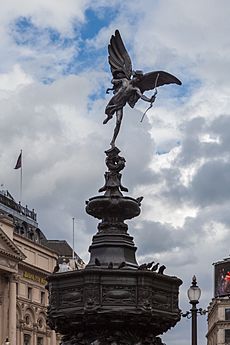New Sculpture facts for kids

The New Sculpture was an exciting art movement in Britain during the late 1800s. It focused on making sculptures look very real and lifelike, often showing spiritual or mythical subjects. Artists created statues and smaller figures, usually made of bronze. Sometimes, they even mixed materials like ivory and gemstones to add color, making the sculptures even more special. This style was most popular from about 1880 to 1910, but some artists kept working in this way even later.
Contents
What Was the New Sculpture Movement?
A Fresh Start for British Sculpture
The name "New Sculpture" was first used by an art writer named Edmund Gosse in 1894. Before this movement, British sculpture often looked very formal and classical, like ancient Greek or Roman art. But in the late 1800s, artists wanted to try something different. They aimed for more natural and realistic sculptures, showing people and things as they truly appear.
How French Art Influenced British Artists
A French sculptor named Jules Dalou played a big part in this change. He lived in England for eight years after some political events in Paris in 1871. During his time in England, Dalou taught at important art schools like the South Kensington School of Art and the Lambeth School of Art. He taught a new generation of British sculptors how to model clay and create more lifelike forms. His teaching really helped to kick-start this new approach to sculpture.
Key Moments and Ideas
The Sculpture That Started It All
Many people believe the New Sculpture movement truly began with an artwork shown in 1877. This was An Athlete Wrestling with a Python by Frederic Leighton. It was Leighton's first big sculpture, and he wanted it to challenge the old ways of making art. The Athlete showed a human body in a very dynamic and energetic pose, which was different from the calm, posed figures usually seen. This sculpture inspired many other artists to create their own dynamic works in the years that followed.
Making Sculpture More Alive
The New Sculpture offered a new direction for art at the end of the 19th century. In France, a famous sculptor named Auguste Rodin started to move away from perfectly realistic human bodies in his work. However, British New Sculptors chose to focus on making the human body look as natural and detailed as possible. They paid close attention to every curve and surface. The New Sculpture wasn't just one single style; instead, it was a collection of different ways artists found to make their sculptures feel more alive and vibrant.
Where to See New Sculpture Art
Exhibitions and Famous Works
In 2010, the Tate Britain museum in London held a special exhibition about the New Sculpture. It featured many important pieces from the movement. Some of the artworks on display included Pandora by Harry Bates, and several small bronze pieces by Alfred Gilbert. You could also see The Singer by Edward Onslow Ford, Lycidas by James Havard Thomas, and The Sluggard by Frederic Leighton. These examples show the variety and skill of the artists involved in the New Sculpture movement.
Important New Sculpture Artists
Many talented artists were part of the New Sculpture movement. Some made big contributions, while others were influenced by the main artists. Here are some of the sculptors connected to this exciting period:
- C. J. Allen
- Harry Bates
- Gilbert Bayes
- Sir Thomas Brock
- William Robert Colton
- Benjamin Creswick
- Jules Dalou
- Conrad Dressler
- Alfred Drury
- Henry Charles Fehr
- Edward Onslow Ford
- George Frampton
- William Silver Frith
- Alfred Gilbert
- Margaret Giles
- Albert Hodge
- Frank Lynn Jenkins (1870–1927)
- Goscombe John
- Édouard Lantéri
- Thomas Stirling Lee
- Frederic Leighton
- Ruby Levick
- Andrea Carlo Lucchesi
- Bertram Mackennal
- Thomas Nelson Maclean (1845–1894)
- Paul Raphael Montford
- Esther Mary Moore
- Edwin Roscoe Mullins
- Henry Albert Pegram
- Charles James Pibworth (1878–1958)
- F.W. Pomeroy
- Henry Poole
- William Reynolds-Stephens
- John Wenlock Rollins (1862–1940)
- Ellen Mary Rope
- Frederick Schenck, active 1886–1907
- George Blackall Simonds
- Lilian Simpson
- Florence Steele
- John Macallan Swan
- James Havard Thomas
- Hamo Thornycroft
- Albert Toft
- Alfred Turner
- Arthur George Walker
- Reginald Fairfax Wells
- Lucy Gwendolen Williams
- Francis Derwent Wood

